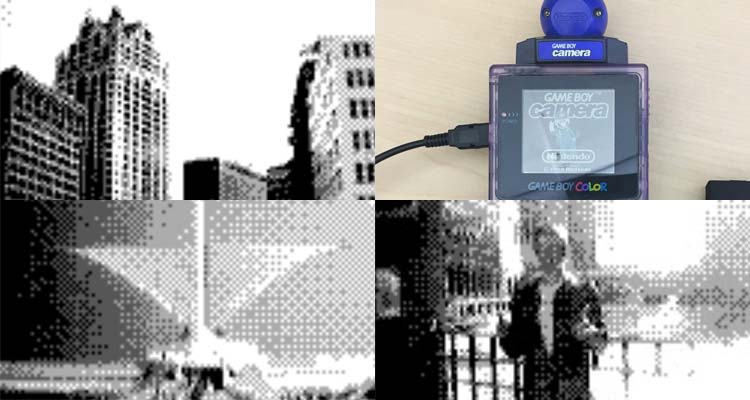In the era of hi-res smartphone cameras and even higher-res professional cameras, Milwaukee has never looked better. Poke around online and you’ll find oodles of gorgeous pictures of the city we love. But for one local photographer, Milwaukee looks just as good in heavily pixelated (and we mean heavily pixelated) black and white: Enter Joshua Arter, who, for the last few years, has been photographing Milwaukee with a 20-year-old Game Boy Camera. The fruit of Arter’s retro-minded labors are collected on his “8bitMKE” Instagram and Twitter accounts.
“I’ve been a big fan of video games, photography, and Milwaukee, so it just kind of came together,” Arter tells us. “I discovered a pretty dedicated Game Boy Camera scene online and became obsessed.”
The Game Boy Camera was released in 1998, an accessory to Nintendo’s ever-popular Game Boy. It sported a 128×128 pixel CMOS sensor and could store 30 128×112 black and white digital images. Though novel and in many ways ahead of its time (it was once recognized by Guinness World Records as the world’s smallest digital camera), the Game Boy Camera was a relative flop. Decades later, however, it lives on thanks to the efforts of enthusiasts like Arter.
“I have a handful of Game Boys: the OG big grey hulk, a clear purple Game Boy Color, a teal Game Boy Color, and a Game Boy Advance SP,” he says. “I use the clear purple Game Boy Color because it was one I picked up as a kid, and it just has some sentimentality to it.”
Arter began his project in earnest in 2017, with a shot of the Milwaukee Art Museum. Since then, he has photographed everything from downtown landmarks and architecture to everyday street scenes and the Riverwest 24. Part of the charm of the lo-res snapshots is often figuring out what, exactly, they depict.
“I do most of my shooting over my lunch break,” Arter says. “I work at Zizzo Group in the Third Ward, so it’s pretty easy to walk around and shoot some pics. Really the only limitation is that being low-res black and white, things have to be pretty contrasting or defined, so a lot of architecture gets featured. I’ve taken plenty of photos that I think would be cool, but once you see them, you really can’t make out what they actually are.
“I absolutely love this city, so I’m constantly thinking of ways to expand the scope of 8bitMKE,” Arter adds. “I’ve done a few other Milwaukee-centric projects, and there’s so much more to the city that I want to highlight than just downtown. I plan on trying to put together a 30-picture run of a few neighborhoods.”
While seeing Milwaukee through an 8-bit lens is fun, dealing with wonky digital technology from two decades ago poses a host of technical difficulties.
“The Game Boy Camera itself holds 30 shots,” Arter says. “Unfortunately, the process for getting images off the camera and onto my computer was super hack-y. Like, I had to download virtual desktops running Windows 97 or Windows XP or something. So my Game Boy Camera just sat in a box for a long time until about a year ago. I randomly came across this thing called a BitBoy, a 3D-printed box with an Arduino chip in it that was coded to emulate the Game Boy Printer, but it would actually save the files to an SD card via USB. Ever since getting it, I’ve just been shooting as much as I can: 15 to 20, 30 pics at a time, dumping them to Dropbox, then going out for more.”
Incredibly, the Game Boy Camera includes a bevy of bells and whistles, including editing functions, mini games, and even a chiptune music sequencer.
“There’s a timelapse setting, a self-timer, mirrored images, and panoramas, which is all pretty impressive considering how low-tech it is,” Arter says. “I’ve used the timelapse setting to make little loops, and I’ve recently done field recordings while I take timelapse photos, which is a nice little touch.”
In the end, Arter says, the best part of his Game Boy Camera project isn’t necessarily the photos—it’s the process.
“For me the big charm comes from people’s reactions. Every time I go out to shoot, I have at least one or two people ask what I’m doing. They usually ask if I’m just hanging out on the corner playing Game Boy, but I’m like, ‘Nope! Taking photos!’ So then I’ll ask people if they want to take a picture, all that. It’s fun. It’s contagious.”

